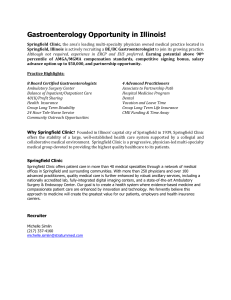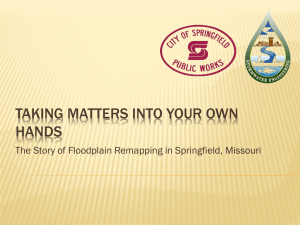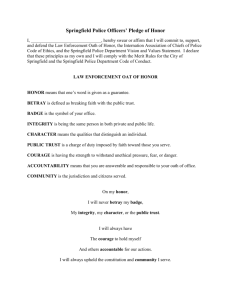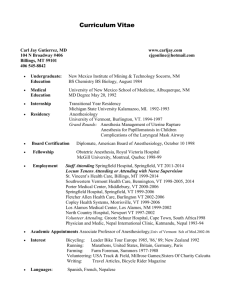Implementing Conservation Design for
advertisement
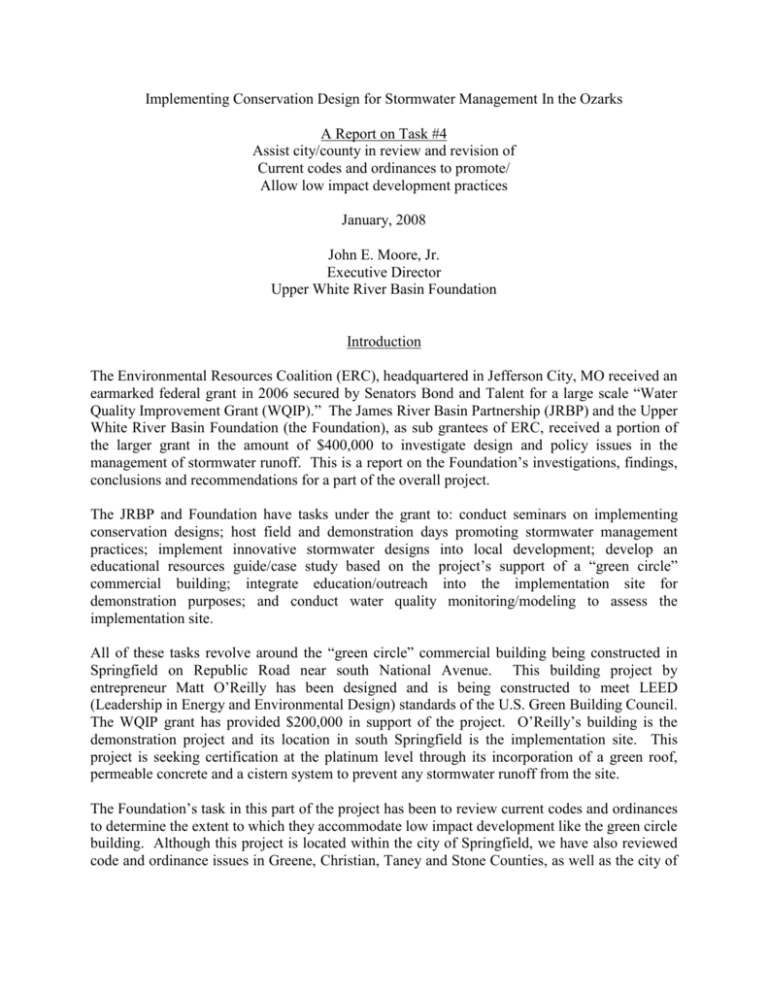
Implementing Conservation Design for Stormwater Management In the Ozarks A Report on Task #4 Assist city/county in review and revision of Current codes and ordinances to promote/ Allow low impact development practices January, 2008 John E. Moore, Jr. Executive Director Upper White River Basin Foundation Introduction The Environmental Resources Coalition (ERC), headquartered in Jefferson City, MO received an earmarked federal grant in 2006 secured by Senators Bond and Talent for a large scale “Water Quality Improvement Grant (WQIP).” The James River Basin Partnership (JRBP) and the Upper White River Basin Foundation (the Foundation), as sub grantees of ERC, received a portion of the larger grant in the amount of $400,000 to investigate design and policy issues in the management of stormwater runoff. This is a report on the Foundation’s investigations, findings, conclusions and recommendations for a part of the overall project. The JRBP and Foundation have tasks under the grant to: conduct seminars on implementing conservation designs; host field and demonstration days promoting stormwater management practices; implement innovative stormwater designs into local development; develop an educational resources guide/case study based on the project’s support of a “green circle” commercial building; integrate education/outreach into the implementation site for demonstration purposes; and conduct water quality monitoring/modeling to assess the implementation site. All of these tasks revolve around the “green circle” commercial building being constructed in Springfield on Republic Road near south National Avenue. This building project by entrepreneur Matt O’Reilly has been designed and is being constructed to meet LEED (Leadership in Energy and Environmental Design) standards of the U.S. Green Building Council. The WQIP grant has provided $200,000 in support of the project. O’Reilly’s building is the demonstration project and its location in south Springfield is the implementation site. This project is seeking certification at the platinum level through its incorporation of a green roof, permeable concrete and a cistern system to prevent any stormwater runoff from the site. The Foundation’s task in this part of the project has been to review current codes and ordinances to determine the extent to which they accommodate low impact development like the green circle building. Although this project is located within the city of Springfield, we have also reviewed code and ordinance issues in Greene, Christian, Taney and Stone Counties, as well as the city of 2 Branson. This is the report of what we found, along with conclusions and recommendations supporting the overall purposes of this portion of the WQIP grant. Low Impact Design Concepts There is a growing awareness and concern for environmental issues. The cost of foreign oil dependence, increasing energy use, water quantity and quality, global warming and carbon “footprints,” are all terms used in connection with these growing environmental concerns. Not limited to legal and regulatory arenas, these concerns are gaining wider cache among citizens, and are reflected nationally in voluntary standards and locally in public policy impacting environmental issues, particularly in the field of construction and development. A widely emerging meaning for “green” refers to concepts or approaches which are environmentally friendly and minimize adverse impacts on the environment. The adjective “green” applied to building design and construction encompasses sustainable consideration of indoor environmental health, site development, water savings, stormwater reduction, energy efficiency, and material use. Terms like “sustainable” and “low impact” are often used in a substantially interchangeable way with “green.” In 1998 the U.S. Green Building Council established standards for green buildings through its LEED program, an acronym for Leadership in Energy and Environmental Design. This is the oldest program certifying green or low impact projects and has become the most widely known and the most widely used. A more recent alternative is the Model Green Building Guidelines sponsored by the National Association of Home Builders, scheduled to be available in 2008. These new guidelines are being reviewed for certification by the American National Standards Institute. A growing number of architectural and engineering firms are well versed in low impact, sustainable concepts and promote these approaches with clients. Builders also recognize that green building concepts are new issues with which they must be familiar. Likewise local cities and counties through their building services, planning and zoning departments are encountering more enquiries and proposals for such developments without respect to whether such projects are seeking LEED or other certification. Indeed some local governmental bodies have adopted and promoted their own version of green building standards. The question addressed in this study involves the degree to which local codes and ordinances accommodate these emerging concepts in development, design and construction and what measures might bring low impact design and code requirements into greater harmony. A Summary of What We Found Building codes, typically the International Building Code, have not been adopted in every jurisdiction checked, but where codes have been adopted, they do not, generally, impede or complicate the approval of low impact projects. Neither do they explicitly promote such projects. These codes speak to the way buildings/homes are constructed but are non-directive or flexible on such issues as materials used, energy efficiency, water savings and indoor 3 environmental concerns. Code administrators interviewed reported their willingness to accommodate building plans incorporating sustainable design concepts and several builders and architects confirmed that this had been their experience. Most issues involving the management of stormwater reside in planning, zoning and development ordinances rather than in building codes where such codes are present. These ordinances regulate the development of residential subdivisions and commercial centers and prescribe the way streets, curbing, gutters, storm drains and detention basins are designed and installed. In the case of Springfield, new stormwater regulations have been developed during the past year. In several of the counties reviewed including Greene County, the planning departments expressed skepticism about applications from developers for “low impact” designs. These designs frequently propose the elimination of prescribed standards for storm water treatment, thus saving development costs without a conscientious, thoroughgoing, true “low impact” plan. Although such proposals may be approved, they receive detailed reviews to verify a bona fide low impact commitment and plan. Nonetheless, county administrators recognize the importance and relevance of emerging low impact design concepts and are considering ways to accommodate and incentivize them further. Wastewater treatment is another issue of concern to developers and county regulators alike. The maintenance of water quality depends everywhere on adequate wastewater treatment. The state regulates municipal wastewater treatment plants and generally county health departments oversee individual on-site wastewater treatment systems (septic tanks). While the latter are subject to increasingly stringent regulations for design and installation, there are advanced treatment systems which can serve multiple properties effectively with proper operation and maintenance. In several counties like Greene and Christian such clustered systems are not allowed by regulation, reflecting negative experience with package systems installed by developers which failed for lack of appropriate maintenance. In these cases, the county inherited the task of remediating a failed treatment system. Observations from the Field In interviewing a number of building and planning and zoning officials, architects, engineers, builders and consultants for this study, a number of observations were offered which are summarized below. These comments provide a context in which green building concepts are now evolving in this region. This summary will provide a basis for conclusions and recommendations from this study which will follow. Green design is still an evolving concept and regulatory issue. While these concepts are still fairly new but familiar to architects and builders, they are increasingly becoming “main stream.” The costs of utilities and payback cycles have an affect on green design. The market will drive more widespread application of green design concepts. Builders will build what the market will support. 4 Utility costs (in Springfield) are relatively low and do not provide the same incentives for green building design as observed in other areas. The average homeowner may own a house for seven years, not long enough to return investments in green design. (Building) codes emphasize life safety and are generally flexible and accommodating on green design concepts and don’t present any unusual problem for developers. New developments (developers, bankers) tend to be risk-averse with respect to new design concepts like low-impact buildings. Green projects are now often being done for “PR” and marketing reasons, seeking to capitalize on a growing popular trend. Over the years, the policy approach to development has encouraged sprawl rather than density which has less environmental impact. Some counties do not now permit clustered wastewater treatment systems and allow only individual on-site systems (septic tanks) in areas where municipal treatment systems are unavailable. Advanced systems serving multiple users are quite effective when properly operated and maintained, but the liability attached to unmaintained, failing systems has been problematic. Development projects often have been “over-engineered” with an attitude that sites must be drained, with impervious surfaces directing runoff to storm systems which potentially contribute to storm event flooding and non-point source pollution of watersheds. There has been less interest to date in getting water back into the local ecosystem. Costs of green design are an issue. Although some projects show calculations supporting no net increase in costs for green design, other estimates indicate cost increases of 2-3% on the low end to as much as 12-15% of basic project cost at the upper end. As more developments are based on green design concepts, any added costs will continue to decline. “Best management practices” (BMP’s) in low impact storm water design include such things as curbless streets, bioswales, rain gardens and pervious paving. These are valid approaches to managing runoff, but they are all “active systems” which have to be managed and maintained. Cars can drive off curbless streets causing ruts and erosion; plantings in rain gardens have to be maintained; pervious paving has to be “unclogged;” and bioswales can be filled in by residents who want their yard level to the street. Counties and cities may have inadequate capability to maintain these kinds of BMP’s. 5 Although the new stormwater design criteria manual has not been formally adopted by the City of Springfield, it is in use and being followed by engineers in project design. This manual has tended to deemphasize the “over engineering” of storm water planning and gives greater attention to the incorporation of low impact design techniques. Regulations in the form of codes, plans and ordinances establish reasonable standards for development. In many cases they exist in the form they do because some previous developments have taken shortcuts or been inadequate in some way in the interest of saving front end costs with problems later left to property owners, municipalities and/or counties. “The city was receptive to our (green) designs and worked with us in their development and approval, but wanted to check and verify our calculations carefully.” Conclusions and Recommendations Clearly there is a growing awareness of green, low impact design concepts and projects. As these concepts and projects become increasingly “main stream,” and as cost implications are more precisely defined, market demand will likely be the driver of new green developments. Building codes emphasizing life safety concerns seem to be essentially neutral on green design concepts. Building codes, where they exist in the Ozarks, are not an apparent problem and accommodate low impact developments fairly easily. Storm water management, regulated by planning, zoning and public works departments in cities and counties, presents a greater challenge to developers proposing low impact designs. Code or ordinance requirements for storm water management, often developed from past experience, prompt much greater scrutiny by officials charged with code administration. Yet there has been accommodation and approval for low impact designs, and can be obtained for bona fide projects which are thoughtfully designed and presented. The new storm water design criteria developed by Springfield contain many new elements supporting low impact projects, and engineers following these criteria have been open to their implementation. In advancing the cause of green design, major initiative should focus on policy making bodies like city councils and county commissions and the staffs which support them. The city council in Springfield has been discussing a policy requiring future city projects to incorporate green design concepts. Greene County is considering an incentive allowing green projects to move to the head of the line for review and approval, a policy initiative which could give momentum to this growing trend. A similar incentive offered by a city 6 would certainly add interest in the use of green design principles. The school district in Springfield has discussed a policy requiring new schools to be designed following low impact standards. Permitted wastewater treatment in areas not served by municipal treatment facilities should include advanced clustered systems where assurances are given and a bond posted to provide proper ongoing operation and maintenance of the system. A model county ordinance for such systems needs to be developed which would satisfy the liability problem now perceived by county officials. A Final Reflection We live in an age of increasing environmental concern. The news media and popular culture regularly headline the spectrum of environmental issues, with low impact, green development being prominently mentioned. From the time in the mid-1960’s when the surgeon general issued the report on the dangers of smoking to human health, it has taken three decades or more for this information to become widely understood throughout American culture. Today smokers in many organizations are often considered social pariahs. How long does it take for a concept like green design to permeate our culture to the point where it is preferred and acted upon? Some new things----witness the wide array of technological gadgetry---are quickly adapted. Others including green design, will likely be implemented more slowly. The cost of energy, growing environmental awareness, concern for maintaining water quality and policy initiatives by local councils and commissions all will impact the implementation of green design. Model projects like Matt O’Reilly’s Green Circle development will be helpful in pointing the way. In the meantime, this report will provide a benchmark for where we are and where we may be going. If it does this alone, it will have served its purpose. Interviewees Bob Atchley 7 Senior Planner Christian County Sam Bradley Home Builder Chair, Green Building Committee Home Builders Association of Springfield Professor Michael Buono Director, Hammons School of Architecture Drury University Eddie Coxie Planner Taney County Planning and Zoning Ruth Denham Planner Branson Department of Planning and Development Eric Dove Engineer Olsson Associates Nick Heatherly Director Building Services, City of Springfield Matthew Hufft Architect, Hufft Projects Kansas City, MO Professor Bruce Moore Asst. Director, Hammons School of Architecture Drury University John Oke-Thomas Oke-Thomas and Associates Matt O’Reilly Owner, Dynamic Earth/Green Circle development Sam Proffer Director Building Services, Christian County 8 Ralph Rognstad Director Planning Department, City of Springfield Tim Rosenbury Partner Butler, Rosenbury and Partners Springfield Tim Smith Director of Resource Management Greene County George Van Hoesen Consultant U.S. Green Building Todd Wagner Stormwater Engineer City of Springfield Sharon Wells Executive Director Springfield Board of Realtors Joy Wilson Director Stone County Planning and Zoning Material Reviewed Storm Water Design Criteria, City of Springfield (esp. chapter 10, “Water Quality), 2007. 9 Green Building Program, Jackson County, Missouri. Subtitled “A guide to incorporating sustainable building features to save money, reduce energy usage, and maintain a healthy home.” 1st Edition, 2006. Better Site Design: A Handbook for Changing Development Rules in Your Community, 1998. Center for Watershed Protection, Ellicott City, MD.

